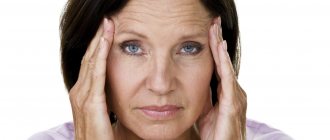The text is for informational purposes only. We strongly urge you not to self-medicate. When the first symptoms appear, consult a doctor. We recommend reading: “Why you can’t self-medicate?”
Menopause (menopause) is the time that marks the end of a woman's menstrual cycles. Menopause is diagnosed after a woman has gone 12 months without a menstrual cycle. The average age of onset of this process is 50 years.
Menopause is a natural biological process. But physical symptoms, such as hot flashes and emotional symptoms, can disrupt sleep, reduce energy, or affect mental health. There are many effective treatments available, ranging from lifestyle adaptations to hormonal therapy.
Hot flashes are the result of hormonal play
The content of the article
What actually happens in a woman's body throughout her life?
The menstrual cycle is the result of regularly recurring hormonal fluctuations. However, the difference is that while a woman is still fertile, these fluctuations are very small. During menopause they gain strength.
The ratio of sex hormones is also different. During menopause, the levels of estradiol and progesterone decrease, and the levels of follicle-stimulating hormone (FSH) and luteinizing hormone (LH) increase.
Changes in the concentration of sex hormones, mainly estrogen deficiency, affect the vascular system. The blood vessels dilate, which the woman perceives as hot flashes. A sudden wave of warmth envelops the head and neck, and a fiery blush covers the face and décolleté. These are symptoms of the so-called angioedema. They can be of varying intensity and last from 30 seconds to 30 minutes.
Hot flashes are also often associated with dizziness, heavy sweating, and increased heart rate. If they appear at night, they can effectively disrupt sleep. This is why women during menopause complain of insomnia, wake up irritable and cannot concentrate on their work.
Hot flashes and dizziness
Fortunately, hot flashes that accompany menopause can be combated, both with home remedies and with the help of pharmacotherapy.
Thyroid dysfunction
During normal functioning, the thyroid gland produces special hormonal substances that are involved in regulating the toning of the vascular system, producing heat energy and the processes of the menstrual cycle.
Therefore, any pathological changes that occur in the functioning of the thyroid gland manifest themselves similarly to the climacteric symptoms of the early menopausal period: the occurrence of hot flashes, sweating and irregularities in the menstrual cycle.
There are two main pathological conditions of the thyroid gland:
- Hypothyroidism is a pathological change in the thyroid gland, characterized by a decrease in its functionality and the level of hormones it produces. With the development of this disease, the following symptoms are noted: a constant feeling of lethargy and drowsiness, decreased appetite and a significant gain of extra pounds, increased swelling, and the formation of hot flashes. The formation of sudden hot flashes with a hot feeling of heat is not typical for reduced functionality of the thyroid gland, but cases have been reported when women at a young age experienced symptoms such as increased sweating and sudden heat during mild physical activity.
- Hyperthyroidism is a disease characterized by extremely increased functionality of the thyroid gland and the highest level of production of thyroid hormonal substances. This pathological process is accompanied by weight loss, disturbances in healthy sleep and the appearance of insomnia, an acute stage of irritability, increased heart rate, and protruding eyes (bulging eyes). Special characteristic features of the development of hyperthyroidism are the formation of hot flashes and cessation of the menstrual cycle and absence of menstruation, as well as excessive night sweats.
The symptoms of pathological changes in the functioning of the thyroid gland are very similar to the menopausal manifestations of the menopausal period. Therefore, if any deviations from the norm are detected in the state of health, it is necessary to undergo diagnostics to make an accurate diagnosis and prescribe appropriate treatment.
To normalize the general condition of a woman and restore the menstrual cycle, hormonal or anti-hormonal (for hyperthyroidism) drugs can be prescribed.
Tip 1. Switch to a balanced diet
Diet during menopause has a huge impact on a woman’s well-being. It is not only the timing of meals, which should be more or less constant, and the frequency that is important, but also, above all, what ends up on the plate.
- The more vegetables and fruits, the better.
- It is worth focusing on low-fat dishes and whole grains, while limiting proteins and animal fats.
- Flaxseed or olive oil should always be a part of the kitchen.
Diet during menopause
In addition, during menopause, a woman should limit her salt intake. When consumed in large quantities, it increases blood pressure, which can worsen hot flashes and other menopausal symptoms. Not to mention, salt promotes water retention in the body, which can make a woman feel like she is gaining weight.
It is also good to enrich the daily menu with products containing phytoestrogens, these are plant substances with estrogen-like effects. They are found in flax or pumpkin seeds.
Another equally important ingredient is folic acid. This vitamin supports the functioning of the hematopoietic and nervous systems. It is found mainly in leafy vegetables, citrus fruits, meats, yeast and grains. Folic acid lowers serum homocysteine (Hcy) levels, which reduces the risk of coronary artery disease, heart attack and stroke. In turn, by interacting with neurotransmitters such as serotonin and norepinephrine, it can significantly reduce the frequency of hot flashes.
Drinking chilled drinks, including diluted apple cider vinegar, and avoiding hot spices may also help combat hot flashes.
Other symptoms of menopause
Why do hot flashes occur in women after 50? The reasons for this condition are hidden in the onset of menopause. About 80% of women suffer from this disease. As for the remaining 20%, they may experience other signs of menopause. These include irritability, headaches, tearfulness, difficulty falling asleep and surges in blood pressure.
Tip 3: Consider Hormone Replacement Therapy
Since menopause symptoms are associated with a stop in the production of hormones in the ovaries, the gynecologist may offer the patient so-called hormone replacement therapy (HRT). It consists of delivering missing hormones to the body in order to balance them to the desired level.
HRT is effective in reducing menopausal symptoms, including hot flashes. However, it should be remembered that this treatment option is not suitable for every woman. Contraindications to hormone replacement therapy will include: breast cancer, endometrial cancer and thromboembolism.
Diagnostics
Considering that high temperature during menopause is often a sign of various diseases, it is important to consult a general practitioner or family doctor if symptoms develop. It is very important that the attending physician is able to differentiate the elevated temperature and exclude pathologies. Otherwise, there is an increased risk of developing a pathological or inflammatory process in the body. Diagnosis is carried out in several ways:
- blood test for inhibin A and B levels;
- general blood test and anti-Mullerian level, showing ovarian reserve;
- test for the presence of follicle-stimulating enzyme. Otherwise it is called a menopause test. It is freely available in pharmacies. If the result is more accurate, it is recommended to take a laboratory test;
- determination of prolactin and cortisol levels. If the indicator is high, elevated temperature indicates stress.
Tip 6: Monitor the air temperature
Too high a temperature can increase the frequency of hot flashes. Therefore, a woman during menopause should avoid heat and frequently ventilate the apartment, especially before bed.
In conclusion, although menopause is an integral part of a woman's life, it does not have to be associated with bothersome symptoms such as hot flashes. We can reduce the frequency of their occurrence in various ways, for example, through a diet rich in phytoestrogens, hormone replacement therapy, and other methods.
ONLINE REGISTRATION at the DIANA clinic
You can sign up by calling the toll-free phone number 8-800-707-15-60 or filling out the contact form. In this case, we will contact you ourselves.
If you find an error, please select a piece of text and press Ctrl+Enter
Who needs treatment?
How to minimize hot flashes in women? The causes and treatment of this condition are described below.
According to experts, about 15% of women who experience fairly strong and painful sensations of heat need special therapy. It was noted that more frequent and intense attacks are experienced by those representatives of the fairer sex who have suffered breast cancer or artificial (early) menopause, which occurred due to the removal of the uterus, ovaries, exposure to radiation or chemotherapy.
Those women for whom a sudden feeling of heat complicates their lives and does not allow them to sleep soundly at night, and reduces their performance during the day, should definitely visit a gynecologist and endocrinologist in order to receive all the necessary recommendations for the treatment of this unpleasant condition.
Menopause and its phases
Menopause (menopause) is a period during which gradual involution (decay) of reproductive functions occurs. The ovaries do not produce estrogen, menstruation disappears, and the woman loses the ability to conceive. The cause of menopause is the natural aging of the body.
This period occurs in three stages:
- premenopause _ Hormonal changes are just beginning, periods do not disappear yet, but become irregular, and PMS symptoms intensify. The emotional state becomes unstable, mood swings are observed. The first hot flashes also appear, accompanied by increased sweating. This period lasts about 5 years and ends with the disappearance of menstruation;
- menopause. This phase begins in the month of complete cessation of menstruation and lasts about a year. The ovaries completely lose their functions. Unpleasant symptoms intensify: hot flashes repeat up to several dozen times a day, sudden changes in pressure occur, and heart rhythm is disturbed. The body becomes susceptible to various diseases. It is during this period that serious diseases become more active: diabetes, osteoporosis, hypertension;
- postmenopause . It begins after menopause and continues for the rest of life. At this stage, the hormonal levels return to normal, severe symptoms disappear and the woman feels a significant improvement in her condition.
Hot flashes in women: causes, folk remedies
The reasons for the appearance of such a condition as hot flashes were presented above. How can the frequency and intensity of these events be reduced? According to experts, there are a huge number of medicinal plants on sale that contain phytohormones that can reduce the severity and number of hot flashes. In addition, they reduce sweating, improve mood, relieve irritability and improve sleep.
Of course, you should not expect positive changes in the first days of treatment. This therapy lasts quite a long time, in courses. The intake of herbs must be alternated. It is not advisable to take them for longer than three months.
Like traditional medicines, such plants also have contraindications. In this regard, before herbal medicine, it is necessary to study information about the selected plant or consult with specialists. It should also be remembered that when taking hormonal drugs, it is prohibited to use herbs that contain natural hormone-like substances.
So how to treat hot flashes in women? The reasons and folk remedies are presented in this article.
- Pour two large spoons of linden flowers into one glass of boiling water and leave for 20 minutes. Strain the resulting liquid and drink every day for three weeks.
- Pour two dessert spoons of hop cones into a bowl and pour 200 ml of boiling water. Cover the raw material with a lid and leave for about 40 minutes. Take the strained solution 1/3 cup three times a day half an hour before meals.
- Pour boiled water over two dessert spoons of crushed sage leaves and leave to infuse. After 25 minutes, the medicinal solution will be ready. It should be drunk in the morning or in two doses. The course of such therapy lasts for two weeks. It is advisable to carry it out in the first phase of the menstrual cycle.
- Oregano herb in the amount of one large spoon is poured into 200 ml of boiling water. After 20 minutes, the infusion will be completely ready for use. Its dosage is one glass twice a day. If desired, you can stir one spoon of honey in it.
- Place about 200 g of crushed red rowan fruits in a sterile jar and fill it with 500 ml of vodka or cognac. Infusion of raw materials is carried out in a dark cabinet for three weeks. The resulting medicinal product is filtered. Its dosage is a dessert spoon three times a day.
If the hot flashes are very severe, then experts recommend making the following collection:
- wormwood herb;
- linden flowers;
- peppermint leaves;
- fennel fruit;
- buckthorn bark.
The listed ingredients should be taken in equal quantities. They are placed in a thermos and filled with 500 ml of boiling water. The dosage of this infusion is one glass twice a day.
It should also be noted that during menopause, plants such as sweet clover, meadow clover, red brush, common mantle, licorice and lemon balm are useful.











